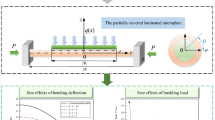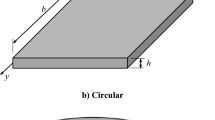Abstract
This paper presents a non-classical refined shear deformation theory model in conjunction with the isogeometric analysis for the static bending, free vibration, and buckling behaviors of multilayered microplates. The modified couple stress theory is used to account for the small-scale effect. Taking a five-layer (Al, P3HT: PCBM, PEDOT: PSS, ITO, and Glass) organic solar cell as an example, it is found that the small-scale effects lead to a decrease in deflection, but an increase in the natural frequency and buckling load. With consideration of the size effect (l/h = 1), the stresses are almost 5 times as much as that without the size effect (l/h = 0). This is why the size effect should be taken into account. Besides, the maximum tensile stress occurs in the ITO layer, which is the dangerous layer. In addition, the normalized deflections increase with increasing aspect ratio, but the normalized natural frequencies and normalized buckling loads decrease with increasing aspect ratio.







Similar content being viewed by others
References
Comello, S., Reichelstein, S., Sahoo, A.: The road ahead for solar PV power. Renew. Sustain. Energy Rev. 92, 744–756 (2018)
Guney, M.S.: Solar power and application methods. Renew. Sustain. Energy Rev. 57, 776–785 (2016)
Fukuda, K., Yu, K., Someya, T.: The future of flexible organic solar cells. Adv. Energy Mater. 2000765 (2020)
Duc, N.D., Seung-Eock, K., Quan, T.Q., Long, D.D., Anh, V.M.: Nonlinear dynamic response and vibration of nanocomposite multilayer organic solar cell. Compos. Struct. 184, 1137–1144 (2018)
Li, Q., Wu, D., Gao, W., Tin-Loi, F.: Size-dependent instability of organic solar cell resting on Winkler–Pasternak elastic foundation based on the modified strain gradient theory. Int. J. Mech. Sci. 177, 105306 (2020)
Yang, Z., Yang, J., Liu, A., Fu, J.: Nonlinear in-plane instability of functionally graded multilayer graphene reinforced composite shallow arches. Compos. Struct. 204, 301–312 (2018)
Zhang, A., Wang, B.: Temperature and electric potential fields of an interface crack in a layered thermoelectric or metal/thermoelectric material. Int. J. Therm. Sci. 104, 396–403 (2016)
Shoaee, S., Briscoe, J., Durrant, J.R., Dunn, S.: Acoustic enhancement of polymer/ZnO nanorod photovoltaic device performance. Adv. Mater. 26, 263–268 (2014)
SoltanRezaee, M., Bodaghi, M., Farrokhabadi, A., Hedayati, R.: Nonlinear stability analysis of piecewise actuated piezoelectric microstructures. Int. J. Mech. Sci. 160, 200–208 (2019)
Wu, Z., Zhang, Y., Huan, Z.: Solving post-buckling characteristic of thermal-resistance films attached to glass façade via an optimization method. Int. J. Struct. Stab. Dyn. 19, 1950068 (2019)
Chong, A., Yang, F., Lam, D.C., Tong, P.: Torsion and bending of micron-scaled structures. J. Mater. Res. 16, 1052–1058 (2001)
Stölken, J.S., Evans, A.: A microbend test method for measuring the plasticity length scale. Acta Mater. 46, 5109–5115 (1998)
Ansari, R., Gholami, R.: Size-dependent modeling of the free vibration characteristics of postbuckled third-order shear deformable rectangular nanoplates based on the surface stress elasticity theory. Compos. B Eng. 95, 301–316 (2016)
Eringen, A.C.: Nonlocal polar elastic continua. Int. J. Eng. Sci. 10, 1–16 (1972)
Toupin, R.: Elastic materials with couple-stresses. (1962)
Yang, F., Chong, A., Lam, D.C.C., Tong, P.: Couple stress based strain gradient theory for elasticity. Int. J. Solids Struct. 39, 2731–2743 (2002)
Fleck, N., Hutchinson, J.: A phenomenological theory for strain gradient effects in plasticity. J. Mech. Phys. Solids. 41, 1825–1857 (1993)
Zhang, B., He, Y., Liu, D., Lei, J., Shen, L., Wang, L.: A size-dependent third-order shear deformable plate model incorporating strain gradient effects for mechanical analysis of functionally graded circular/annular microplates. Compos. B Eng. 79, 553–580 (2015)
Akgöz, B., Civalek, Ö.: Modeling and analysis of micro-sized plates resting on elastic medium using the modified couple stress theory. Meccanica 48, 863–873 (2013)
Lu, P., Zhang, P., Lee, H., Wang, C., Reddy, J.: Non-local elastic plate theories. Proc. R. Soc. A Math. Phys. Eng. Sci. 463, 3225–3240 (2007)
Papargyri-Beskou, S., Beskos, D.: Static, stability and dynamic analysis of gradient elastic flexural Kirchhoff plates. Arch. Appl. Mech. 78, 625–635 (2008)
Lam, D.C., Yang, F., Chong, A., Wang, J., Tong, P.: Experiments and theory in strain gradient elasticity. J. Mech. Phys. Solids. 51, 1477–1508 (2003)
Fleck, N., Hutchinson, J.: A reformulation of strain gradient plasticity. J. Mech. Phys. Solids. 49, 2245–2271 (2001)
Eringen, A.C.: On differential equations of nonlocal elasticity and solutions of screw dislocation and surface waves. J. Appl. Phys. 54, 4703–4710 (1983)
Toupin, R.: Elastic materials with couple-stresses. Arch. Ration. Mech. Anal. 11, 385–414 (1962)
Li, Z., He, Y., Lei, J., Guo, S., Liu, D., Wang, L.: A standard experimental method for determining the material length scale based on modified couple stress theory. Int. J. Mech. Sci. 141, 198–205 (2018)
Tsiatas, G.C.: A new Kirchhoff plate model based on a modified couple stress theory. Int. J. Solids Struct. 46, 2757–2764 (2009)
Jomehzadeh, E., Noori, H., Saidi, A.: The size-dependent vibration analysis of micro-plates based on a modified couple stress theory. Phys. E Low Dimens. Syst. Nanostruct. 43, 877–883 (2011)
Yin, L., Qian, Q., Wang, L., Xia, W.: Vibration analysis of microscale plates based on modified couple stress theory. Acta Mech. Solida Sinica. 23, 386–393 (2010)
Ma, H., Gao, X.-L., Reddy, J.: A non-classical Mindlin plate model based on a modified couple stress theory. Acta Mech. 220, 217–235 (2011)
Gao, X.-L., Huang, J., Reddy, J.: A non-classical third-order shear deformation plate model based on a modified couple stress theory. Acta Mech. 224, 2699–2718 (2013)
Ansari, R., Rajabiehfard, R., Arash, B.: Nonlocal finite element model for vibrations of embedded multi-layered graphene sheets. Comput. Mater. Sci. 49, 831–838 (2010)
Phadikar, J., Pradhan, S.: Variational formulation and finite element analysis for nonlocal elastic nanobeams and nanoplates. Comput. Mater. Sci. 49, 492–499 (2010)
Liu, S., Yu, T., Bui, T.Q., Xia, S.: Size-dependent analysis of homogeneous and functionally graded microplates using IGA and a non-classical Kirchhoff plate theory. Comp. Struct. 172, 34–44 (2017)
Roque, C., Ferreira, A., Reddy, J.: Analysis of Mindlin micro plates with a modified couple stress theory and a meshless method. Appl. Math. Model. 37, 4626–4633 (2013)
Shimpi, R.P.: Refined plate theory and its variants. AIAA J. 40, 137–146 (2002)
Hughes, T.J., Cottrell, J.A., Bazilevs, Y.: Isogeometric analysis: CAD, finite elements, NURBS, exact geometry and mesh refinement. Comput. Methods Appl. Mech. Eng. 194, 4135–4195 (2005)
Bhardwaj, G., Singh, I.V., Mishra, B.K., Bui, T.Q.: Numerical simulation of functionally graded cracked plates using NURBS based XIGA under different loads and boundary conditions. Compos. Struct. 126, 347–359 (2015)
Bui, T.Q., Hirose, S., Zhang, C., Rabczuk, T., Wu, C.T., Saitoh, T., Lei, J.: Extended isogeometric analysis for dynamic fracture in multiphase piezoelectric/piezomagnetic composites. Mech. Mater. 97, 135–163 (2016)
Yin, S., Yu, T., Bui, T.Q., Liu, P., Hirose, S.: Buckling and vibration extended isogeometric analysis of imperfect graded Reissner-Mindlin plates with internal defects using NURBS and level sets. Comput. Struct. 177, 23–38 (2016)
Yu, T., Yin, S., Bui, T.Q., Liu, C., Wattanasakulpong, N.: Buckling isogeometric analysis of functionally graded plates under combined thermal and mechanical loads. Compos. Struct. 162, 54–69 (2017)
Samaniego, E., Anitescu, C., Goswami, S., Nguyen-Thanh, V.M., Guo, H., Hamdia, K., Zhuang, X., Rabczuk, T.: An energy approach to the solution of partial differential equations in computational mechanics via machine learning: Concepts, implementation and applications. Comput. Methods Appl. Mech. Eng. 362, 112790 (2020)
Nguyen-Thanh, N., Zhou, K., Zhuang, X., Areias, P., Nguyen-Xuan, H., Bazilevs, Y., Rabczuk, T.: Isogeometric analysis of large-deformation thin shells using RHT-splines for multiple-patch coupling. Comput. Methods Appl. Mech. Eng. 316, 1157–1178 (2017)
Vu-Bac, N., Duong, T.X., Lahmer, T., Zhuang, X., Sauer, R.A., Park, H., Rabczuk, T.: A NURBS-based inverse analysis for reconstruction of nonlinear deformations of thin shell structures. Comput. Methods Appl. Mech. Eng. 331, 427–455 (2018)
Thai, H.-T., Choi, D.-H.: Analytical solutions of refined plate theory for bending, buckling and vibration analyses of thick plates. Appl. Math. Model. 37, 8310–8323 (2013)
Liu, S., Yu, T., Lich, L.V., Yin, S., Bui, T.Q.: Size and surface effects on mechanical behavior of thin nanoplates incorporating microstructures using isogeometric analysis. Comput. Struct. 212, 173–187 (2019)
He, L., Lou, J., Zhang, E., Wang, Y., Bai, Y.: A size-dependent four variable refined plate model for functionally graded microplates based on modified couple stress theory. Compos. Struct. 130, 107–115 (2015)
Nguyen, H.X., Nguyen, T.N., Abdel-Wahab, M., Bordas, S.P., Nguyen-Xuan, H., Vo, T.P.: A refined quasi-3D isogeometric analysis for functionally graded microplates based on the modified couple stress theory. Comput. Methods Appl. Mech. Eng. 313, 904–940 (2017)
Thai, H.-T., Kim, S.-E.: A size-dependent functionally graded Reddy plate model based on a modified couple stress theory. Compos. B Eng. 45, 1636–1645 (2013)
Thai, H.T., Choi, D.H.: A refined plate theory for functionally graded plates resting on elastic foundation. Compos. Sci. Technol. 71, 1850–1858 (2011)
Liu, S., Yu, T., Bui, T.Q.: Size effects of functionally graded moderately thick microplates: a novel non-classical simple-FSDT isogeometric analysis. Eur. J. Mech. A Solids. 66, 446–458 (2017)
Reddy, J.: An introduction to the finite element method. McGraw-Hill, New York (2004)
Acknowledgements
This research was supported by the Research Innovation Fund of Shenzhen City of China (Project No. JCYJ20170811160538023) and the National Natural Science Foundation of China (Project Nos. 11972133, 11972137).
Author information
Authors and Affiliations
Corresponding authors
Additional information
Publisher's Note
Springer Nature remains neutral with regard to jurisdictional claims in published maps and institutional affiliations.
Appendices
Appendix A: a brief on NURBS basis functions
For the sake of completeness, the NURBS basis function is introduced in this section. More details can be found in Refs. [37, 46]. A knot vector, \({\varvec{k}}\left( \xi \right)\), is a set of non-decreasing numbers between zero and one, \({\varvec{k}}\left( \xi \right) = \left\{ {\xi_{1} = 0, \ldots ,\xi_{i} , \ldots ,\xi_{n + p + 1} = 1} \right\}^{{\text{T}}}\) with i representing the knot index, \(\xi_{i}\) is the ith knot, n is the number of basis functions, and p the order of the polynomial [34]. By using the given knot vector \({\varvec{k}}\left( \xi \right)\), the ith B-spline basis function of degree p, termed as \(N_{i,p} \left( \xi \right)\), is defined recursively as follows:
and
For two-dimensional (2D) problems, the NURBS basis functions can be constructed by taking the tensor product of two 1D B-spline basis functions [37]:
where wi,j is the weight in 2D; \(N_{i,p} (\xi )\) and \(N_{j,q} (\eta )\), respectively, are the B-spline basis functions of order p in the ξ direction and order q in the η direction; \(N_{j,q} (\eta )\) follows the recursive formula shown in Eq. (13) with knot vector \({\varvec{k}}\left( \eta \right)\). The definition of \({\varvec{k}}\left( \eta \right)\) is the same as that of \({\varvec{k}}\left( \xi \right)\).
In addition, the C2-continuity is required in this paper. The second-order derivatives of the NURBS basis function can be described as [51]
with
Appendix B: discrete equations for bending, free vibration, and buckling
The displacements in the middle plane are approximated as
with
where NP = (p+1)(q+1) is the number of control points per physical element, RI and uI denote the shape function and the unknown displacement vector at the control point I.
Substituting Eq. (15a) into both Eqs. (7) and (9), one can obtain
The strain energy of the OSC microplate is
The virtual work done by external forces is
where \(N_{ij}^{0}\) and qs are in-plane critical buckling load and applied transverse loading, x1 and x2 represent x and y, respectively.
The variation of the kinetic energy of the mass system is written as
According to Hamilton’s principle, we have
Substituting Eqs. (B3)–(B11) into Eq. (B12), and applying the weak formulation [52], then we can obtain the weak form for static deformation, free vibration, and buckling.
Rights and permissions
About this article
Cite this article
Liu, S., Wang, K., Wang, B. et al. Isogeometric analysis of bending, vibration, and buckling behaviors of multilayered microplates based on the non-classical refined shear deformation theory. Acta Mech 232, 2991–3010 (2021). https://doi.org/10.1007/s00707-021-02992-9
Received:
Revised:
Accepted:
Published:
Issue Date:
DOI: https://doi.org/10.1007/s00707-021-02992-9




